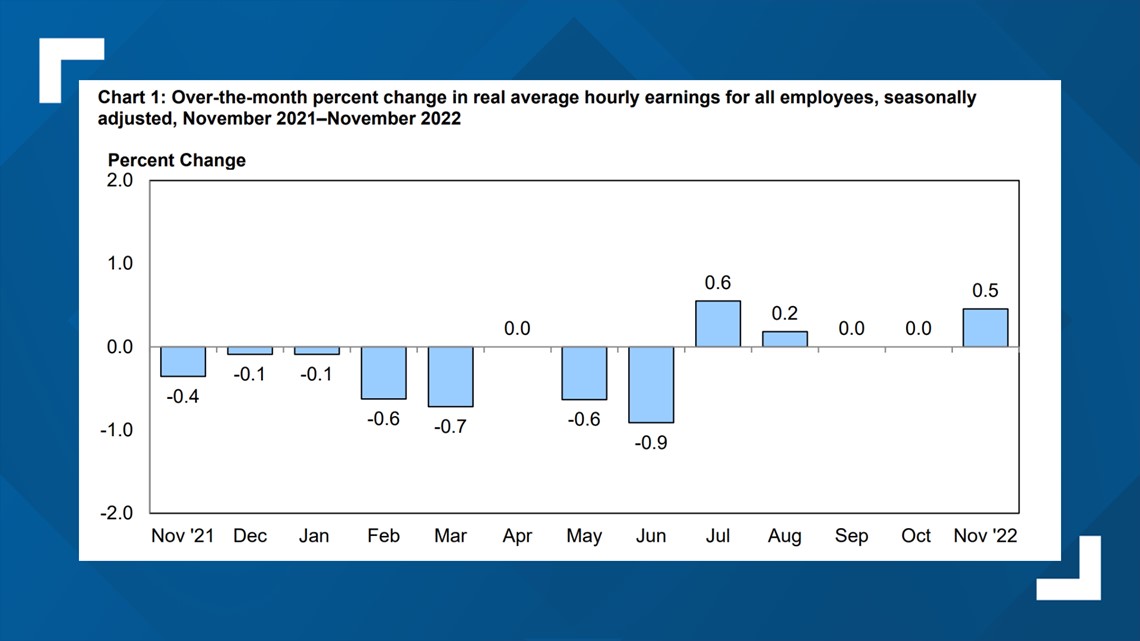President Joe Biden gave a short speech Tuesday to address the issue of inflation in the economy.
Year-over-year inflation peaked in June, at 9.0%, according to the Bureau of Labor Statistics. It’s since declined to 7.1% in November, but that remains higher than in any year since 1982.
In his speech, Biden acknowledged prices still remain at historic highs, but celebrated the apparent slowdown of inflation, and claimed wage growth has begun to outpace it.
“For the last several months, wages have gone up more than prices have gone up,” he said.
THE QUESTION
Over the last several months, have wages gone up more than prices?
THE SOURCES
THE ANSWER
Yes, since July, average hourly earnings have increased at a faster rate than the Consumer Price Index, which measures changes in the prices of goods and services. But price increases still remain larger than wage growth for the year on the whole.
WHAT WE FOUND
“Wages” and “prices” are both pretty broad concepts, and costs and salaries can vary a lot from person to person. But the Bureau of Labor Statistics does have a way to keep track of the overall trends.
First, it surveys hundreds of thousands of payrolls every month, and uses that data to calculate the average hourly earnings of all private sector employees.
Second, it measures inflation through the Consumer Price Index, which tracks the prices of a bunch of commonly bought goods, showing whether a basket of those same goods is getting cheaper or more expensive.
Once it has those two stats, it can measure whether wages are keeping up with inflation through a metric called Real Earnings. To calculate Real Earnings, simply take a given month’s percent increase in earnings, and subtract the percent increase in CPI to account for inflation.
If the result is a positive number, that means wages are growing faster than inflation; a negative number means inflation is outpacing wage growth.
The latest report shows a positive number in November. There were also positive numbers in July and August. September and October were actually net zero, suggesting wages and inflation grew at the exact same pace in those months. And before July, the numbers were consistently negative – except for another net-zero month in April.


MORE FROM VERIFY: No, there isn’t a limit to how many times the Federal Reserve can adjust interest rates
That means in the first half of 2022, prices were growing faster than wages. But in the second half, wages began to outpace prices.
We can also do a more direct comparison to show the overall trend in the past six months combined, as opposed to each month individually. Hourly wages in April 2022 averaged $31.98 according to data compiled by the Federal Reserve. The CPI was $292.30 in that same month. In November, wages rose to $32.82 per hour on average while the CPI was $297.71.
That comes out to a 2.63% growth in wages over that six-month span, versus a 1.85% growth in prices. Subtract 1.85 from 2.63, and you get a positive number – a 0.78% growth in Real Earnings over the past six months.
One popular claim on social media said “actually, prices have increased faster than wages for a record 20 consecutive months,” and provided a graph that appeared to back up that claim.
The graph also shows Real Earnings, but instead of comparing each month to the month previous, it compares each month to that same month in the prior year. So for example, although prices grew just 0.1% from October 2022 to November 2022, they grew 7.1% between November 2021 and November 2022.
Looking at year-over-year figures, it is true that the last 20 months in a row show a decline in Real Earnings compared to the year prior. But when looking at the current trend – meaning the change in prices and wages each month relative to the last – it’s also true that the last six months show wage growth outpacing inflation.












